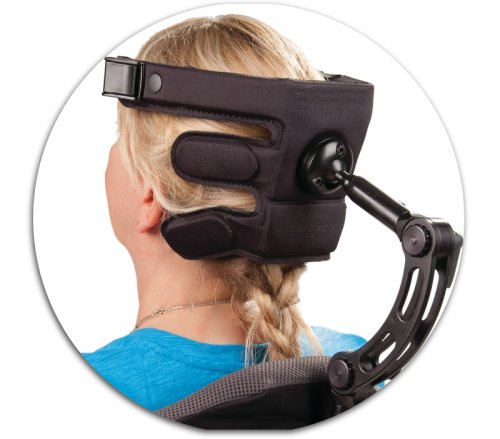Special Wheelchair Headrest For Head Control Providing Full Command & Support
This is a really special wheelchair headrest that offers complete control of the head. It is airy and cool, light-weight and can easily be shaped by hand. The Savant is really a combination headrest and head/neck support used for injuries to the cervical spine, and neuromuscular diseases like ALS, Muscular Dystrophy, Multiple Sclerosis, Drop Head Syndrome, Advanced Degenerative Spinal Conditions and Neck Muscle Degeneration.
This head control wheelchair headrest provides support at three levels on the head to control lateral flexion (ear towards shoulder), rotation (nose toward shoulder), and flexion (chin to chest). The wheelchair headrest for head control is available for both kids and adults.
Many times stabilizing head is a must for those with significant neck injuries and nuromuscular disease who require the use of a wheelchair. Not all headrests are created equal; many are uncomfortable and difficult to adjust. Below you will learn the benefits of the Savant Wheelchair Headrest and why it’s so easy to use, not to mention how comfortable it is for the user.
So many headrests for wheelchair users are obtrusive and lack the stabilization that a lot of patients need, especially with the head dropping forward. The ones that do offer some type of forward head control are usually very uncomfortable for the wearer and can be a general nuisance. Headbands that are difficult to use are more likely to go unused by, especially those hired or have the task of to caring for the patient
The wheelchair headrest for head control comes with a headband that is comfortable and very easy to use. It has quick release clamps that hold it securely to the patients head, and special pads for added comfort. Securing the head comfortably to the headrest will keep the head from falling forward, something that can possibly causing breathing problems, difficulty eating or speaking, or further neck injury.
This particular headrest is designed for maximum comfort and ease of use. The light weight construction removes the burden of maneuvering heavy, cumbersome head pieces by the caregiver. All of the support pads can be adjusted simply by gently bending them with your hands, making fine adjustments easier than regular head supports. The padded supports on the headrest and headband contains a gel substance to improve comfort and relieve pressure points. This is very important because with limited mobility, pressure sores and ulcerations are a big problem that can be difficult to heal. Avoiding these pressure issues is much easier with the soft gel filled pads on this headrest.
The three levels of support bars are designed to be hand adjustable to the proper fit. The mid-level pads are shaped to lie comfortably behind the ears so they don’t rub on the ears or block hearing. The upper level pads control the temple and upper head. This upper pad is where you would connect the headband. The bottom support controls the base of the head. All this means total, comfortable and customizable head stabilization.
Mounting hardware lets you have a choice between standard and other special mounts for extra control. So, there is a variety of wheelchair mounting options specifically designed for the Savant as well as other headrests.
The Savant can also be paired with the Axion Rotary, which is an interface between the headrest and hardware to allow additional control of positioning in rotation.
Savant & Axion Paired For Rotational (Left & Right) Motion
The optional side pad is an extension for the headrest that provides padding and extends the top support which provides additional support for the side of the head. The side extension pad can also be employed for switch mounting, however the headband cannot be used with the side pad.
A number of adapters are available to easily fit the headrest to practically any existing equipment, even cloth or vinyl back chairs!
Finding the most comfortable and caregiver friendly headrest can seem like a huge challenge. However, this wheelchair headrest for head control offers one of the best solutions, specifically designed with both caregiver and patient in mind. Comfort, a low profile design, light weight and easy to adjust make this one of the innovative and unique wheelchair headrests available today.
According to a 2019 article in Neurology International, the dropped head syndrome is also known as as floppy head syndrome and was first described in 1986. The syndrome is displays weakness against gravity of the neck extensor muscles with or without neck flexor muscle weakness. It can be an isolated problem presenting with difficulty or inability in raising the head or it be part of a generalized muscular disease resulting in lack of head control.




